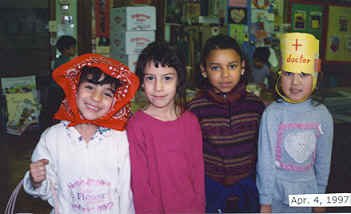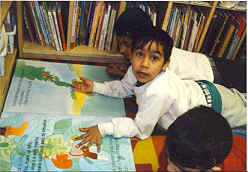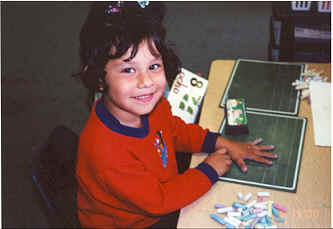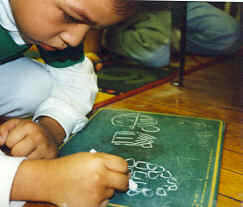

Congruent to my personal philosophy of learning and my personal views about play, I have selected a transformational curriculum, aimed to build foundations for literacy, numeracy, and critical thinking. This approach assumes that the curriculum changes and that the learner is also capable of changing/affecting such curriculum. I ask them what they want to learn about a topic, and then we try to find out these ideas together. This type of curriculum is the result of an interaction between the children and myself, with both contributing ideas. It is a negotiated and emergent curriculum. Curtis and Carter (1996) describe it this way:
An emergent curriculum has as much structure as a teacher-directed approach. The difference is that the source of the structure is the teacher's understanding and responsiveness to the children, rather than a curriculum recipe or set plan. The teacher and the children create the structure... Read about Reflecting Children�s Lives
I remain flexible with an open-minded attitude. Children's own comments and questions may suggest modifications to teacher-suggested activities. While learning objectives remain the same, my school years are never exactly alike. I like this quote from Dizes & Dorl (1999):
An emergent curriculum is a continuous revision process, and honest response to what is actually happening. Good teachers plan and let go. If you are paying attention to children, and accurate lesson plan can be written only after the fact.
Thematically-based activities, units, webs, and collaborative Internet projects try to reinforce concepts within and across domains. Thus, language arts, social studies, math, science, health, music/movement and art, are all integrated and coordinated as a whole. While I integrate different content areas to the curriculum, I help my students learn in a natural environment, using the language experiences approach.
They are read to, they read with me, and are allowed to read on their own. Also, writing is modeled for them, they write with me, and are allowed to write on their own. Social interaction during reading and writing is expected.
During Shared Reading, I read to my children stories that they cannot read for themselves yet. The selection of titles is done based on their relation to the theme under study. They are exhorted to participate along with my reading, especially at repetitive parts. I read a variety of signs around the room, at our school hallways, food recipes, diaries, letters from our friends, newspaper articles, rhymes, lists of "to do things," clothing tags, can labels from our dramatic play area, or any other interesting material that we find on our way.

During Shared Reading the use of Big Books is very effective. Since I do
not own that many, I frequently use chart paper to write poems, chants and songs using a
large font that most children can see from a distance. Currently I am looking for ways to
have these constantly available to students during choice time. We also like to
act out our favorite stories. This help us remember them more as we share our
reading knowledge.
I recommend you these books:
Beyond Storybooks : Young Children and the Shared Book Experience
(1993),
Perspectives on Shared Reading : Planning and
Practice (2000)

My role as a teacher is to support my students' learning, instead of teaching them directly. A group of children, or just one child, talk and think out loud about a story, of which they have a copy. Knowing the different levels that I have in my class, I can determine which questions they need to ask themselves to understand an author. Some children begin by trying to "read" the story's pictures. Others know how to do that before they enter school, through previous encounters with books at home or at preschool. These children are encouraged to deepen their understanding, by helping them to question the pictures, and try to predict what will happen next as part of the story's sequence.
I recommend these three books:
Guided
Reading: Good First Teaching for All Children (1996)
Mosaic of Thought : Teaching Comprehension in a Reader's Workshop (1997)
Matching Books to Readers: Using Leveled Books in Guided Reading,
K-3 (1999)
How
to Teach Balanced Reading and Writing (1999)
Guided
Reading: Making It Work (2000)
This type of reading is not a stage to be reached, but part of every stage of each reader's development. My students know that I refer to them as readers from day one. I encourage them to read and to recognize our room's library as a special place.
Slowly, Jard�n Mundial students learn to seek out our resources for their reading pleasure and to find out unknown information. My students and I enjoy reading to stuffed animals, they are good listeners. As children assume responsibility and control over the books THEY choose to read, our children are on their way to Independent Reading. I believe that placing responsibility on children to make choices enables them to develop autonomy.
I am always trying to improve our classroom environment. Some of my goals during the current school year are to provide more children's magazines with animal pictures on them, and to create more "homemade big books" with my students.



"Reading does not begin suddenly...Reading is no one single skill alone...When a child has the chance to hear one good story after another, day after day, he is being taught to read. When his kindergarten year is a series of mind-stretching eye-filling trips, helping him know more solidly his world, he is being taught to read. When a child hears good adult language, and when he has the fullest freest chance to use his own language, he is being taught to read. When he creates with blocks, when he communicates with paint, when he uses his body freely as a means of expression, he is being taught to read. When a child stares, fascinated, at a picture- when he looks ever so carefully at the scale in his store or at the life in his aquarium, he is being taught to read. When he hammers ever so carefully at the workbench, fashioning his battleship, this too teaches him to read. When he uses his whole body-two eyes, two hands, two arms, two legs and knees and feet- to pull himself up a scary slanted climbing board, he is being taught to read... In the good kindergarten, life doesn't stop so that the children can be taught to read. The life goes on so that the children can be taught to read. The chance to read is ever-present, but never in a coercive or artificial or teacher-dominated way."
Dr. James L. Hymes, Jr. (1965)
The idea here is to model writing for students. With their help, I write sentences on a wipe-erase board or large piece of paper, preferably without lines. Also, we create books of several sizes and shapes, on which they dictate sentences and draw their own pictures. We put them on our room's library for everyone's enjoyment.
Through these encounters, Jard�n Mundial students acquire such skills as left to right directionality, movement from top to bottom on a chosen writing surface, and possible auto corrections during writing. We always read our writings together, to make sure that these make sense, and that the audience will understand them.
I help my students to write, by providing a corner we call the Writing Workshop. We have an alphabet poster, tracing letters, letters to stamp playdough with, color pencils, magic markers, color chalk, crayons, magnetic letters, a number line, glue, scissors, remnants of cloth, construction paper, color paper, staplers, scotch tape, yarn, magazines and old catalogs to cut out, and our "magic board", with pictures and words for the unit under study.
 At the beginning of the school year, many children
come to school believing they do not know how to write. With much support, and by
letting them know that even their scribbles mean something, their self-esteem levels as
writers grow every day that goes by. With many observations during the school year, I can
see changes on their writing development stages (scribbles, isolated-letters, transition,
stylized-sentences, writing) and on their spelling stages (pre-communicative,
semi-phonetic, phonetic, transitional, correct). All of the students' writings are valued
by having them displayed within the classroom, on our hallway, or on our Internet pages.
At the beginning of the school year, many children
come to school believing they do not know how to write. With much support, and by
letting them know that even their scribbles mean something, their self-esteem levels as
writers grow every day that goes by. With many observations during the school year, I can
see changes on their writing development stages (scribbles, isolated-letters, transition,
stylized-sentences, writing) and on their spelling stages (pre-communicative,
semi-phonetic, phonetic, transitional, correct). All of the students' writings are valued
by having them displayed within the classroom, on our hallway, or on our Internet pages.
Students are free to create a combination of text with drawings. If they like they can also use picture word cards as a guide. However, I do not make them copy long texts already written on a board, since this is usually not relevant to every child in my class. If I do this, I risk the chance of my students feeling that writing does not make any sense, and is only a matter of copying letters and leaving spaces. I want children to feel that writing means something to them, that it is functional (a means to an end, and not an end in itself) and as interesting as oral language.
Finally, I should note that my goal is for them to compose (from their head,) even if it is just one word, rather than to copy (from the board.) Composing is the process of expressing one's thoughts, and transcribing is the mechanical part of writing: holding the pencil, forming the letters, spelling, and editing. My responsibility is to foster a balance between these two aspects.


Fields, M. V. & DeGayner, B. (2000, Spring). Read my story. Childhood
education, 76, 130-135.
Greenwald, C. & Hand, J. (1997, Fall). The project approach in
inclusive preschool classrooms. Dimensions of Early Childhood, 25,
35-39.
Meier, D. & Schafran, A. (1999, May). Strengthening the
preschool-to-kindergarten transition: A community collaborates. Young
children, 54, 40-46.
Pianta, R.C. & Kraft-Sayre, M. (1999, May).
Parents�observations about their children�s transitions to kindergarten. Young
children, 54, 47-52.
Smith, A.F. (2000, Spring). Reflective portfolios: Preschool possibilities. Childhood Education, 76, 204-208.
Wanerman, T. (1999, March). The open-door policy: Enhancing
community in a part-time preschool program. Young children, 54, 16- 17.
Camp, A.M., Walmsley, B. B., & Walmsley, S. A. (1992).
Teaching
kindergarten: A developmentally appropriate approach. New Hampshire:
Heinemann.
Clark, P., & Kirk, E. (2000). All-Day Kindergarten. Childhood
Education, 76, 228-231.
Egertson, H.A. (1987). The shifting kindergarten curriculum. ERIC Digest:
ERIC Clearinghouse on Elementary and Early Childhood Education. [On-line]. Available: http://readyweb.crc.uiuc.edu/library/pre1990/egertson.html
Fisher, B. (1991). Joyful Learning: A whole language kindergarten. New Hampshire:
Heinemann
National Center for Education Statistics. (1995). Approaching
kindergarten: A look at preschoolers in the United States. [On-line]. Available: http://nces.ed.gov/pubs/sa95280.html
Nurss, J.R. (1987). Readiness for kindergarten. ERIC Digest: ERIC
Clearinghouse on Elementary and Early Childhood Education. [On-line]. Available: http://readyweb.crc.uiuc.edu/library/pre1990/nurss87.html
Oesterreich, L. (1998). Ages & stages. Iowa State University.
[On-line]. Available: http://www.nncc.org/Child.Dev/ages.stages.5y.html
Pellegrini, A.D. & Glickman, C.D. (1991). Measuring kindergarteners'
social competence. Eric Digest. [On-line]. Available: http://ericae.net/edo/ed327314.htm
Rothenberg, D. (1995). Full day kindergarten programs. Champaign, IL: Eric
Clearinghouse on Elementary and Early Childhood Education (EDO-PS-95-4). [On-line].
Available: http://ericeece.org/pubs/digests/1995/drkind95.html
Salmon, M. (1999, July). My guide for teaching spelling in
Kindergarten. Young children, 54, 67-68.
Shepard, L. A. & Smith, M.L. (1989). Escalating kindergarten
curriculum. ERIC Digest: ERIC Clearinghouse on Elementary and Early Childhood Education.
[On-line]. Available: http://readyweb.crc.uiuc.edu/library/pre1990/sheprd89.html
Wuori, D. (1999, November). Beyond letter of the week: Authentic
literacy comes to kindergarten. Young children, 54, 24-25.
Andrews, J. H. (1988, May). Poetry: Tool of the classroom magician. Young
children, 43, 17-25.
Barclay, K.D. & Walwer, L. (1992, May). Linking lyrics and literacy through
song picture books. Young children, 47, 76-84.
Canizares, S. (1998, October). Literacy: A new look. Early Childhood
Today, 13, 26-33.
Christie, J.F. & Stone, S.J. (1999, June). Collaborative literacy
activity in print-enriched play centers: Exploring the "zone" in
same-age grouping. Journal of Literacy Research, 31, 109-131.
Clay, M.M. (1991, December). Introducing a new storybook to young readers.
The
reading teacher, 45, 264-272.
Clements, N. E. & Warncke, E. W. (1994, March). Helping literacy emerge at
school for less- advantaged children. Young children, 49, 22-26.
Combs, M. (1996). Emerging readers and writers. In Dixon-Krauss, L.
Vygotsky
in the classroom: Mediated literacy instruction and assessment. New York: Longman
Publishers.
Early Childhood Today (1998, October). Sue Bredekamp & Susan Neuman on
learning to read. Early Childhood Today, 13, 36-37.
Enz, B. (1997, February). Assessing young children's literacy: Documenting growth
and informing practice. The reading teacher, 50, 430-434.
Escamilla, K. & Andrade, A. (1992). Descubriendo la lectura: An
application of Reading Recovery in Spanish. Education and urban society, 24,
212-226.
Fresch, M.J. (1995, November). Self-selection of early literacy learners. The
reading teacher, 49, 220-227.
Freppon, P.A. & McIntyre, E. (1999, March/April). A comparison of
young children learning to read in different instructional settings. Educational
Research, 92, 206-218.
Gable, S. (1999, September). Promote children�s literacy with
poetry. Young children, 54, 12-15.
Glazer, S.M. (1992). Reading comprehension: Self monitoring strategies
to develop independent readers. New York: Scholastic.
Goodman, K. (1993). Phonics in reading instruction. In Phonics Phacts
(pp. 105-114).
Hymes, J.L. (1965). Early reading is very risky business. Grade
Teacher, 82, 88-92.
Kontos, S. (1986, November). What preschool children know about reading
and how they learn it. Young Children, 58- 66.
Leonhardt, M. (2000, June). Bringing books to life. Family
Fun Magazine, 88-96.
Lopes, M. (1994). Promoting literacy through whole language. University of
Massachusetts. [On-line]. Available: http://www.exnet.iastate.edu/pages/nncc/Curriculum/promote.literacy.html
Maduram, I. (2000, May). Playing possum: A young child's response to
information books. Language Arts, 77, 391-397.
McMahon, R. (1996, Summer). Introducing infants to the joy of reading. Dimensions
in Early Childhood, 24, 26-29.
Mooney, M. E. (1990). Reading to, with, and by children. New York:
Richard C. Owen Publishers.
Mooney, M. E. (1994). Reading to children: A positive step on the road to
literacy. Teaching PreK-8, 25, 87-92.
Nel, E.M. (2000, Spring). Academic, literacy, and young
children. Childhood education, 76, 136-141.
Neuman, S.B. & Roskos, K. (1990, November). Play, print, and purpose: Enriching
play environments for literacy development. The reading teacher, 44, 214- 221.
Ortiz, R., Stile, S. & Brown, C. (1999, September). Early
literacy activities of fathers: Reading and writing with young children. Young
children, 54, 16-18.
Putnam, L.R. (1994, September). Reading instruction: What do we know now that we
didn't know thirty years ago? Language Arts, 71, 362-366.
Routman, R. (1996, April). Invented spelling: What it is and what it
isn't. School Talk (National Council of Teachers of English), 1.
Schlosser, K. G., & Phillips, V. L. (1992). Building literacy with
interactive charts. New York: Scholastic Professional Books.
Sensenbaugh, R. (1997). Phonemic awareness: An important early step in
learning to read. Bloomington, IN: ERIC Clearinghouse on Reading, English, And
Communication. [On-line]. Available: http://www.kidsource.com/kindsource/content2/phoemic.p.k12.4.html
Snider, V.E. (1995). A primer on phonemic awareness: What it is, why it's
important, and how to teach it. School Psychology Review, 24, 443-455.
Strickland, D. (1989). Emergent literacy: How young children learn to read
and write. In Strickland, D. & Morrow, L. M. (Eds.). Emerging literacy: Young
children begin to read and write. Delaware: International Reading Association.
Traill, L. (1995). Highlight my strength: Assessment and evaluation of
literacy learning. Rigby: Crystal Lake.
Waeaver, C. (1994). Phonics in whole language classrooms. ERIC Digest.
[On-line]. Available: http://www.kidsource.com/kidsource/content2/Phonics.html
Willis, S. (1995, Fall). Whole language: Finding the surest way to
literacy. Association for supervision and curriculum development. 1-8.
Berry, C. F. & Mindes, G. (1993). Theme-based curriculum: Goals,
themes, activities, and planning guides for 4's and 5's. Glenview, IL:
GoodYearBooks.
Burrill, N., Ischerwood, J., & Schlosser, K. (1996). Engaging your
Kindergarten and first grade learners. WA: Bureau of Education & Research.
Butzow, C.M & Butzow, J.W. (1989). Science through children's
literature: An integrated approach. Colorado: Teacher Ideas Press.
Bredekamp, S. & Shepard, L. (1990). Protecting children from
inappropriate practices. Champaign, IL: ERIC Clearinghouse on Elementary and Early
Childhood Education (EDO-PS-90-9). [On-line]. Available: http://readyweb.crc.uiuc.edu/library/1990/brkmp90.html
Bredekamp, S. & Rosegrandt, T. (Eds.). (1992). Reaching individual
potentials through transformational curriculum. In Reaching potential: Appropriate
curriculum and assessment for young children (Vol. 1). Washington: National
Association for the Education of Young Children.
Brooks, J.G. (----). Becoming a constructivist teacher. In The case for
constructivism. ASCD.
Cassidy, D. J. & Lancaster, C. (1993, September). The grassroots curriculum: A
dialogue between children and teachers. Young children, 48, 47- 51.
Chard, S.C. (1999). From themes to projects. Early Childhood Research &
Practice,1 [On-line]. Available: http://ecrp.uiuc.edu/v1n1/v1n1.html
Cordeiro, P. (1993). Becoming a learner who teaches. Teachers
networking: The whole language newsletter, 12, 1; 3-5.
Cummnings, C. (1990). Appropriate public school programs for young
children. Champaign, IL: Eric Clearinghouse on Elementary and Early Childhood Education
(EDO-PS-90-4). [On-line]. Available: http://ericps.ed.uiuc.edu/eece/pubs/digests/1990/cummin90.html
Curtis, D.& Carter, M. (1996). Reflecting
Children's Lives: A Handbook for Planning Child-Centered Curriculum.
Minnesota: Red Leaf Press.
Davenport, M.R., Jaeger, M. Lauritzen, C. & School of Education,
Eastern Oregon State College, La Grande, Oregon, USA. (1996, December/1997, January). A
curriculum of caring. The reading teacher, 50, 352- 354.
Dever, M.T. & Jared, E.J. (1996, March). Remember to include art and crafts
in your integrated curriculum. Young children, 51, 69-73.
Dizes, D. E. & Dorl, J. (1999, July). Your Mop is my guitar:
Emergent curriculum in our classroom. Young children, 54, 14-16.
Dunn, L. & Kontos, S. (1997). Developmentally Appropriate Practice:
What does research tell us? Champaign, IL: ERIC Digest: ERIC Clearinghouse on Elementary
and Early Childhood Education (EDO-PS-97-22). [On-line]. Available: http://ericeece.org/pubs/digests/1997/dunn97.html
ERIC/EECE Resource List. (1997). Developmentally appropriate practices in
primary education. [On-line]. Available: http://ericeece.org/pubs/reslist/dap96.html
Ferguson, C.J. (1999, Summer). Building literacy with
child-constructed sociodramatic play centers. Dimensions of Early Childhood,
27, 23-29.
Gaines, L. (1998, January). Creative movement in the early childhood
curriculum. Scholastic Early Childhood Today, 45-47.
Haughland, S.W. (1999, November). What role should technology
play in young children�s learning?. Young children, 54, 26-31.
Katz, L. (1993). Teacher planning. In Engaging children's mind: The
project approach. New Jersery: Ablex.
Litman, M., Anderson, C., Andrican, L, Buria, B., Christy, C.,
Koski, B. & Renton, P. (1999, May). Curriculum comes from the child! Young
children, 54, 4-9.
Lowe, K. & Johnston, C. (2000, Winter). Reader response: Young
children can do that! Dimensions of Early Childhood, 28, 3-10.
Maehr, J. (1991). Encouraging young children's writing. Champaign, IL:
ERIC Clearinghouse on Elementary and Early Childhood Education (EDO-PS-91-1). [On-line].
Available: http://ericeec.org/pubs/digests/1991/maehr91.html
Manning, M. & G. (1995). Theme-Immersion teachers and two issues they
face. Teaching K-8, 25, 94- 96.
Myhre, S.M. (1993, July). Enhancing your dramatic-play area through the use of
prop boxes. Young children, 48, 6- 11.
Pope Edwards, C. & Wright Springate, K. (1995). Encouraging creativity
in early childhood classrooms. Champaign, IL: ERIC Clearinghouse on Elementary and Early
Childhood Education (EDO-PS-95-14). [On-line]. Available: http://ericeece.org/reggio/edward95/html
Schlosser, K. G., & Phillips, V. L. (1991). Beginning in whole
language: a practical guide. New York: Scholastic Professional Books.
Seefeldt, C. (1995, March). Art-A serious work. Young children, --, 39-
45.
Smith, J. (1995, March). Threading mathematics into social studies. Teaching
children mathematics, 1, 438-444.
Temkin, J. (1994, November 20). Kindergartners getting to the heart of
learning [Education Today]. Chicago Tribune, pp. 3-4.
Ward, C.D. (1996, March). Adult intervention: Appropriate strategies for
enriching the quality of children's play. Young children, 51, 20-25.
Wardle, F. (1999, November). In praise of developmentally
appropriate practice. Young children, 54, 4-12.
Welk, V. (1994). Making your Kindergarten the best it can be. WA: Bureau
of Education & Research.
Workman, S. & Anziano, M. C. (1993, January). Curriculum webs: Weaving
connection from children to teachers. Young children, 48, 4-9.